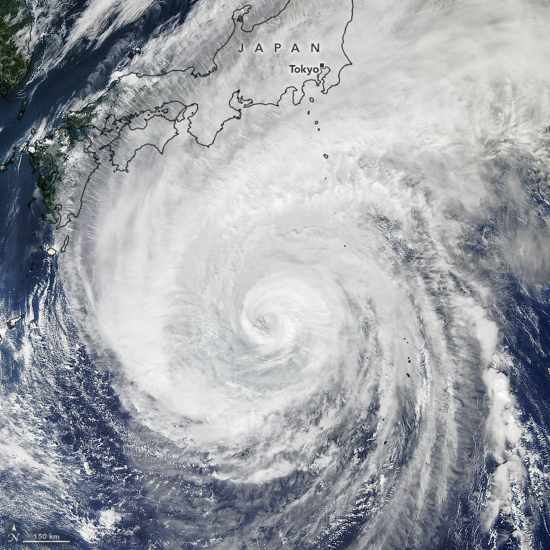Catastrophe risk modelling specialist RMS has now published an estimate for the insurance and reinsurance market impact of recent Japanese typhoon Hagibis, estimating the industry losses at between $7 billion and $11 billion.
 With a mid-point of $9 billion, RMS’s estimated range for the insurance market-wide loss caused by typhoon Hagibis is quite a bit lower than competitor AIR Worldwide’s $8 billion to $16 billion, which gives a mid-point of $12 billion, so 33% higher.
With a mid-point of $9 billion, RMS’s estimated range for the insurance market-wide loss caused by typhoon Hagibis is quite a bit lower than competitor AIR Worldwide’s $8 billion to $16 billion, which gives a mid-point of $12 billion, so 33% higher.
As ever, differences in model output are significant between the two leading providers, suggesting that the insurance and reinsurance market may find that the truth lies somewhere between these two mid-points.
In general, reinsurance and insurance-linked securities (ILS) industry sources continue to indicate that $10 billion to $12 billion would be a likely range that many in the industry will be working from when it comes to setting typhoon Hagibis reserves (so close to the gap between estimate mid-points), but some are looking considerably higher such as RenaissanceRe which believes the storm could be a $15 billion market loss.
Interestingly and again demonstrating the delta between the main catastrophe risk models, RMS said that its estimate includes losses due to property damage and business interruption from typhoon wind and typhoon flood across residential, commercial, industrial, marine, and automobile lines, including both the private and kyosai/mutual markets.
RMS also takes into account the potential for post-event loss amplification and non-modeled losses with Hagibis, including demand surge and claims inflation related to the fact that recent Typhoon Faxai overlapped in terms of area impacted, as well as the widespread damage to infrastructure that occurred.
AIR’s estimate of Hagibis industry losses does not include business interruption or demand surge factors, neither does it include any infrastructure related costs, so it is perhaps interesting that RMS’ estimated range is so much lower, when demand surge and business interruption in particular are likely to be such significant factors in where the Hagibis market loss ends up.
RMS based its industry loss estimate on a reconstructed wind field and flood footprint from its RMS Japan Typhoon HD model, as well as data and insights gained through the field reconnaissance of RMS modelers on the ground.
Typhoon Hagibis is a particularly complex loss event to model, RMS notes, given typhoon Faxai struck just a month earlier and the widespread flood impacts that occurred from Hagibis.
Three RMS teams surveyed the impacted region over a two week period in order to gain a better understanding of the loss event, enabling the company to use factual details about the geographical extent and severity of hazard and impact.
RMS estimates that typhoon related flooding from Hagibis will be a major contributor to the overall insurance and reinsurance market loss, accounting for as much as 60% of the total according to the firm.
Margaret Joseph, Senior Product Manager of the RMS Japan Typhoon Model, commented, “The combined losses from the two recent storms, Typhoon Hagibis and Typhoon Faxai, could rival insured losses from Typhoon Jebi that struck Japan last year.”
As a reminder, RMS had estimated the insurance market loss from Faxai at between $5 billion to $9 billion, for comparison AIR had estimated it at $3 billion to $7 billion.
Interestingly, RMS’ mid-point estimate for Faxai is the higher, at $7 billion, 40% more than AIR’s $5 billion.
It’s also of note that RMS suggests it will take both Faxai and Hagibis to equal Jebi’s industry loss, which gives a $16 billion total, while some others suggest that Faxai and Hagibis could equal both Jebi and Trami (closer to $18 billion or $19 billion based on current market consensus it seems).
However, RenaissanceRe’s CEO Kevin O’Donnell said that his firm puts the combined total of Faxai and Hagibis much higher, at $25 billion (Faxai $10bn, Hagibis $15bn).
What does this all tell us?
That early estimates of catastrophe losses are extremely challenging to make, take significant expertise, domain and risk knowledge. While different strategies and methodologies will come out with sometimes very different numbers.
This is why risk models are considered largely directional in nature, rather than an output of the truth, when it comes to forecasting loss metrics. Which requires re/insurers and ILS funds to undertake expert analysis of their own on these model outputs, to better understand how they could be impacted by catastrophe events.
Also read:
– Faxai loss to near $10bn, Hagibis $15bn, climate change a factor: RenRe CEO.
– RenRe & Markel expect typhoon Hagibis losses to eclipse Faxai.
– At up to $16bn, Hagibis industry loss to drive rates, with creep possible: KBW.
– Typhoon Hagibis industry loss estimated from $8bn to $16bn: AIR.
– Hagibis + Faxai industry loss may be close to Jebi + Trami: Credit Suisse.
– Hagibis loss complex to assess, ILS deductible erosion possible: Twelve.
– Hagibis loss could match Faxai, may accelerate reinsurance rates: KBW.
– No cat bond loss from Hagibis, price impacts to be short-lived: Plenum.
– Typhoon Hagibis causes severe flooding, damage across swathe of Japan.
 View all of our Artemis Live video interviews and subscribe to our podcast.
View all of our Artemis Live video interviews and subscribe to our podcast.
All of our Artemis Live insurance-linked securities (ILS), catastrophe bonds and reinsurance video content and video interviews can be accessed online.
Our Artemis Live podcast can be subscribed to using the typical podcast services providers, including Apple, Google, Spotify and more.































